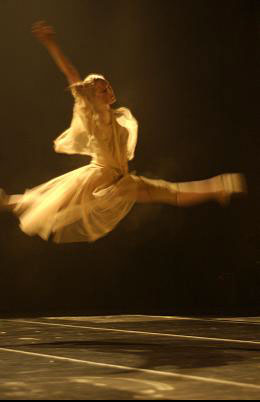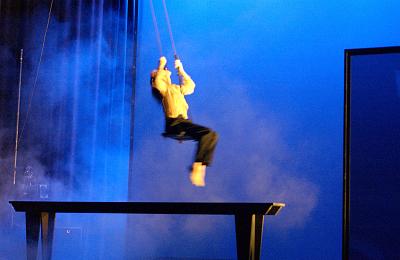Quixote
neither check nor mate just alive |
français
 |
Choreography and stage production: Jânia
Batista and Etienne Frey
Musical creation: Matthieu Ramsauer
Lighting effects:
Jean-Pierre Potvliege
Collaboration to costumes and stage
setting: Fundação Fluminense de ballet et
Rosi Morilla (Picpus)
With: Jania Batista, Etienne
Frey, Alexandra Carey,
Ramon Moraes and the Avant-Scène
Young Ballet

 |
|
How tempting the Don Quixote by Cervantes is …..
The very myth of commonplace. You identify with the lanky
figure. You can picture yourself fighting, pondering over
what is unjust and taking lost causes in hand. Part and
parcel of our cultural domain, the knight of the Sorrowful
Countenance is a silhouette as much as a way of life that
epitomizes our communication folly.
If the Don Quixote myth is closely akin to our modern
reality, it is meaningful and the show must unveil this
inconsistent and tragic face: today's man and woman battling
with the world from their solitary confinement, genuine
social outcasts, absolute pariahs.
Each given situation meant a risky gamble on our part.
Comedy was to be inseparable from the tragic fabric of
events. Dream was to be part and parcel of the real world.
The gestures would be those of our present-day motions.
The sentences would be made of silences, looks, emotions
and dance. One would dare total silence, the pure impression
of movement. One would go as far as extreme inner tension,
which, in turn, would be interrupted by sudden splits,
the use of poetry, and character interplays.
It all requires total oblivion and the ability to agree
to becoming a revealing medium.
Is there not anything sweeter than to dare answer the
call of adventure?
Indeed, to dare fend for oneself and face up to one's
soul.
Was Don Quixote really an erring knight or was he simply
enjoying life and its meanderings? |
On the stage dancers are pawns of their own existence. The choreography
of Jânia Batista and Etienne Frey is a vivid illustration
of this saying:
"Carpe Diem on the chessboard
of life"


This perception of Don Quixote corresponds to an elaboration
on the notion of "letting things go", which is essential
to the two choreographers.
For five years now, Jânia Batista has been questioning
the myth of Don Quixote, wondering about a figure, that of an
original adventurer, who gives himself heart and soul to grasping
his extra share of life. Such is indeed the fight of man when
he wants to step in his own maze, move on that obstacle track,
accept and taste change with his gaze riveted on the horizon.
It is the book by Spencer Johnson "Who has pinched my cheese?"
which has enabled Jânia Batista to find the keys to the
creation of this project.
This is indeed the maze each and every one of us enters in his
early childhood.
"And it would be ever so much simpler
if we had it mapped out from the outset. It is however not so…
everything moves, everything evolves." (S. Johnson)…
even the smallest speck of dust.
The thing to do is to put down roots in the earth and let oneself
be invaded by the flux of water, to experience the cruelty of
fire, to feel quite helpless, and breathe the greatness of life
since we are its actors and not its leaders.
These metaphors might seem simplistic. To us they are of vital
importance.
| neither check, nor mate,
just alive |
|
|